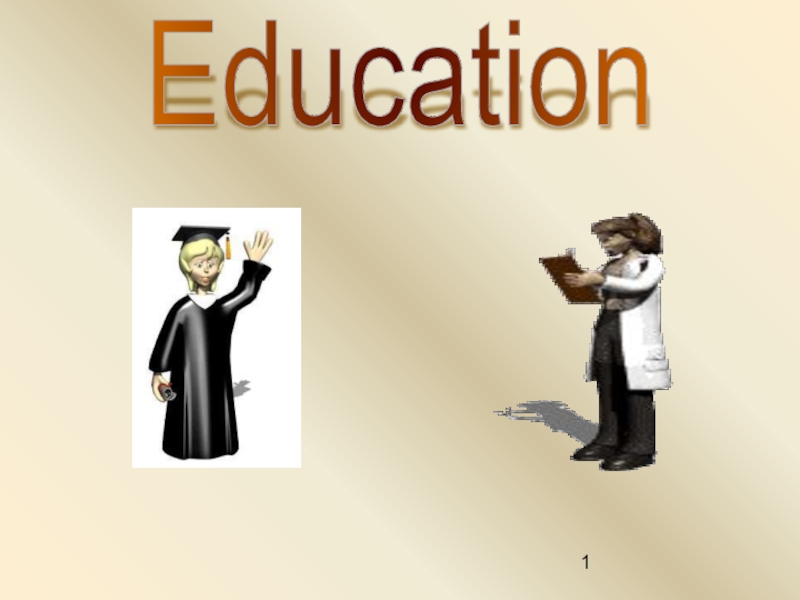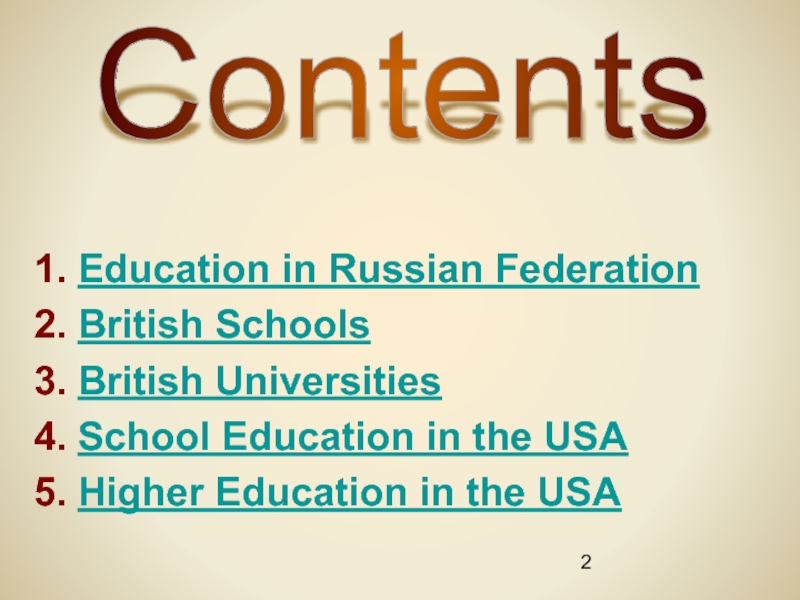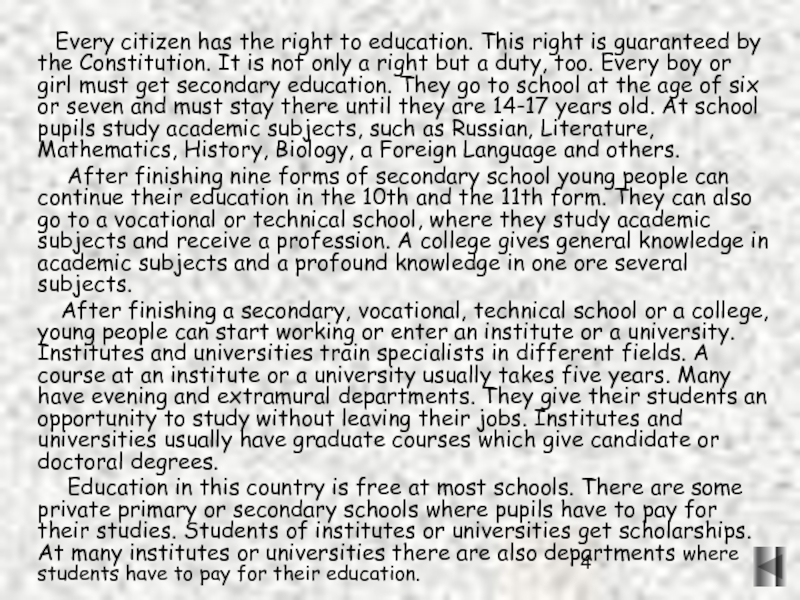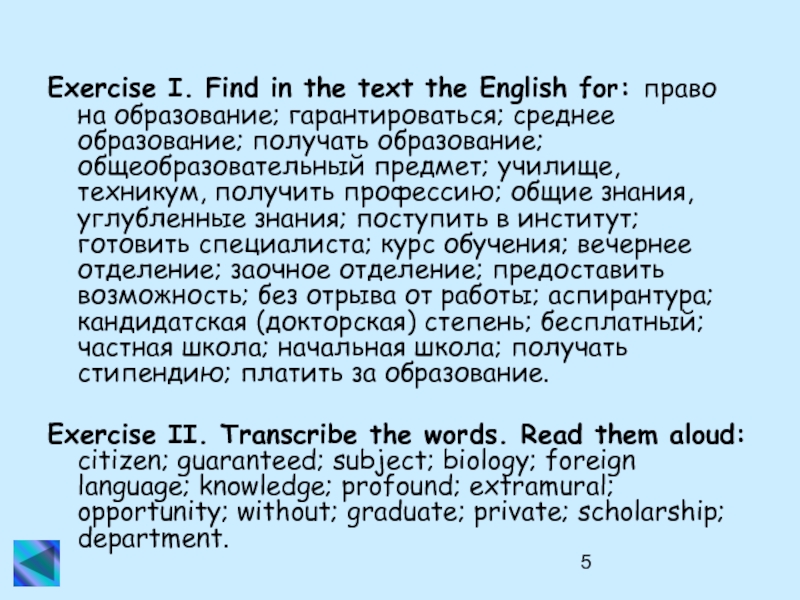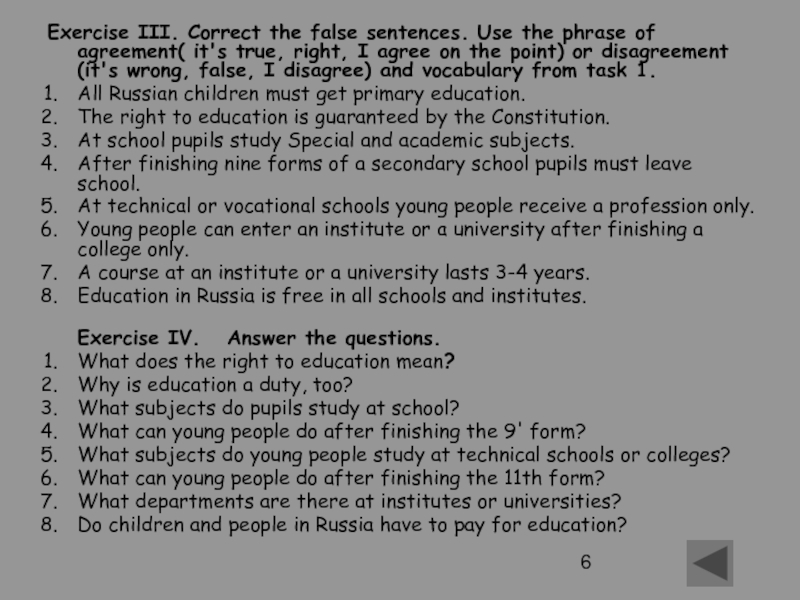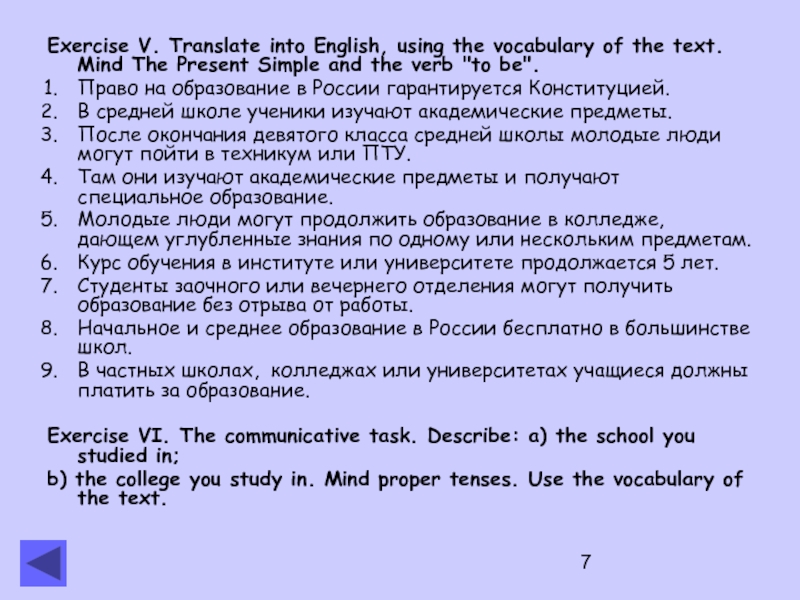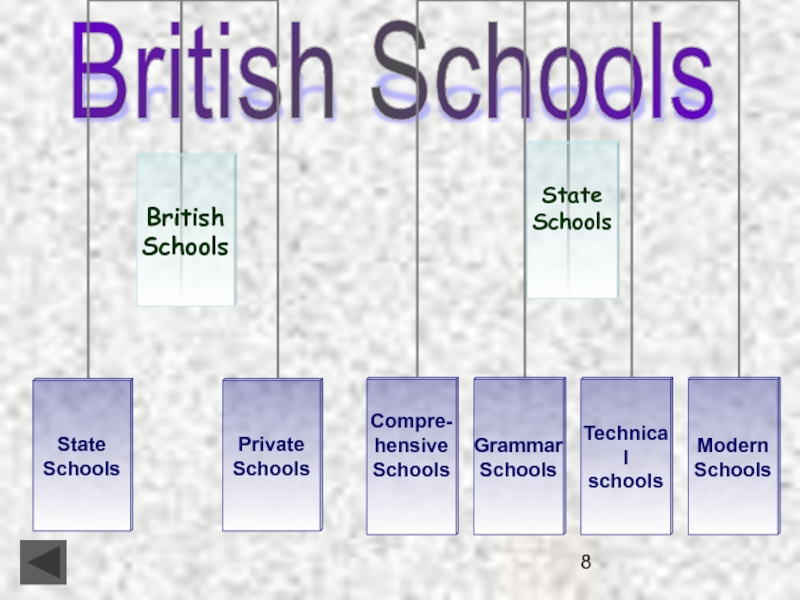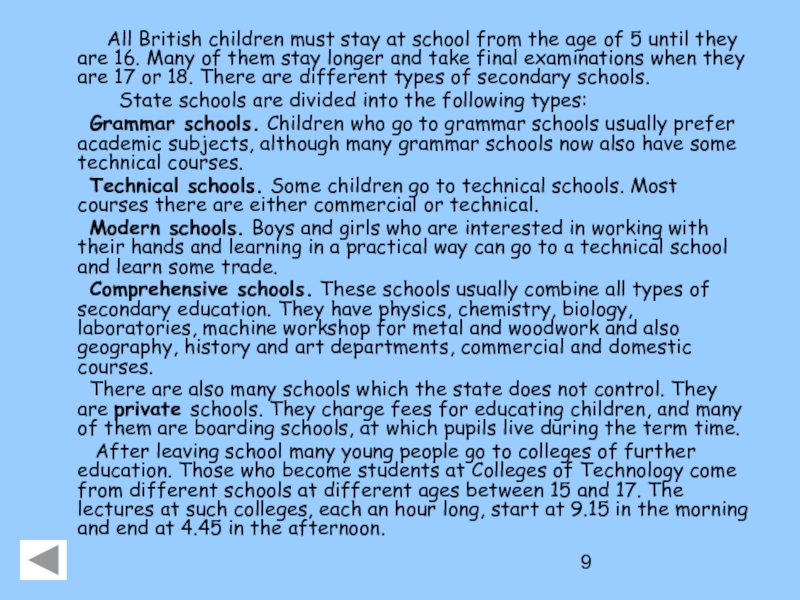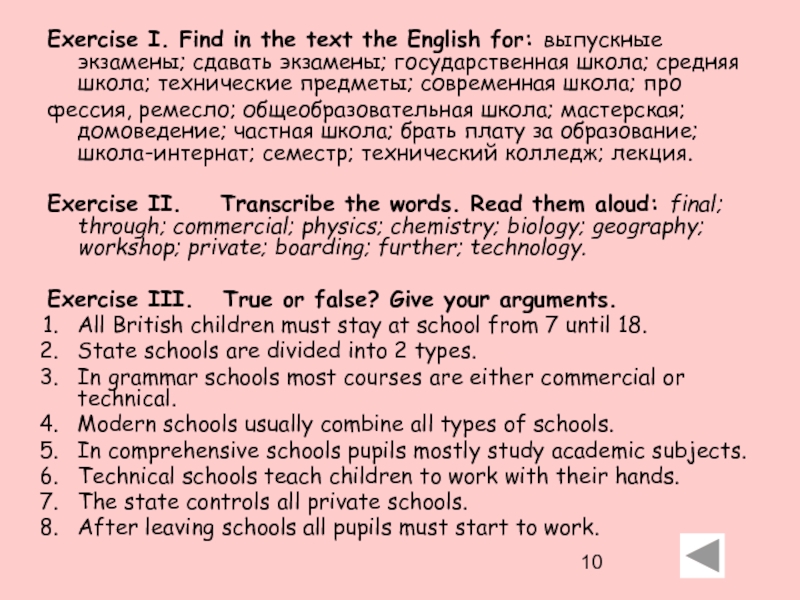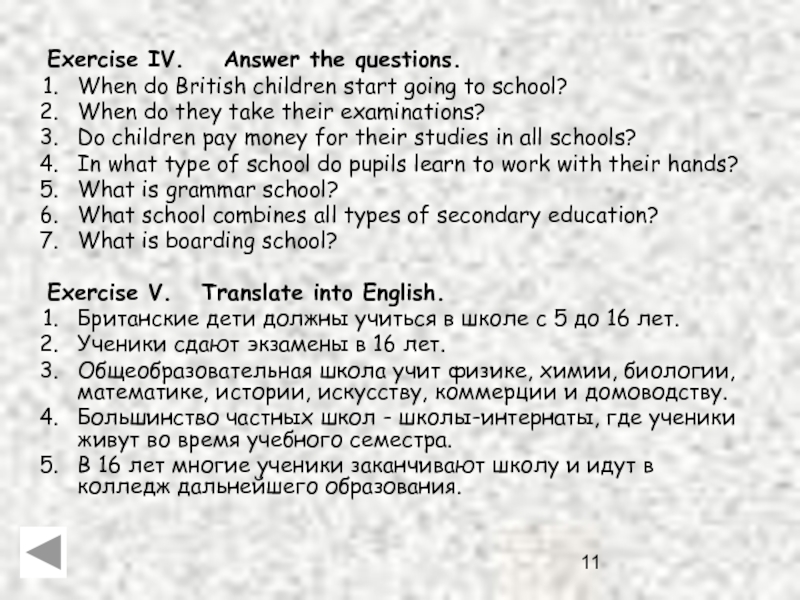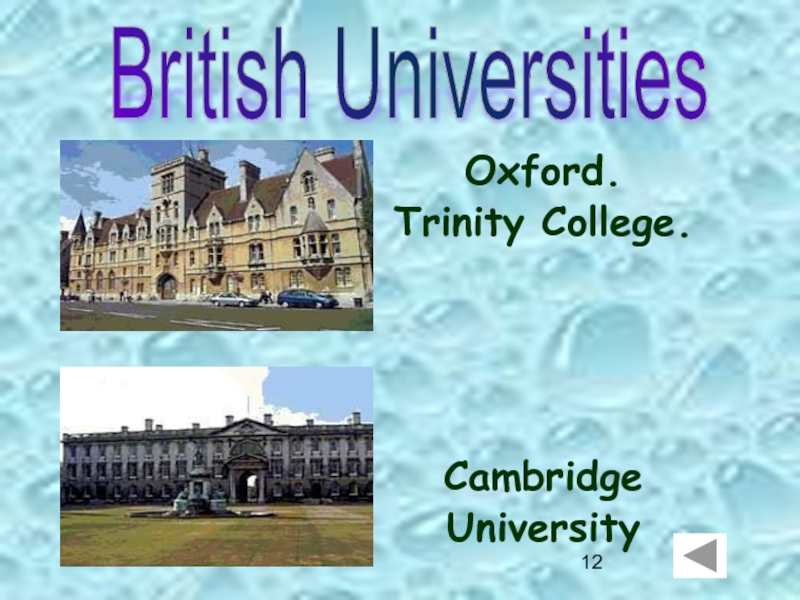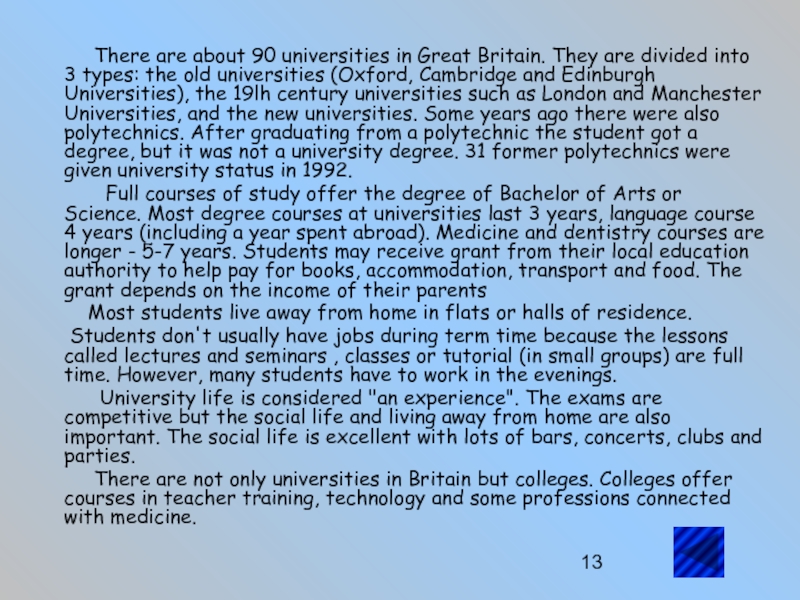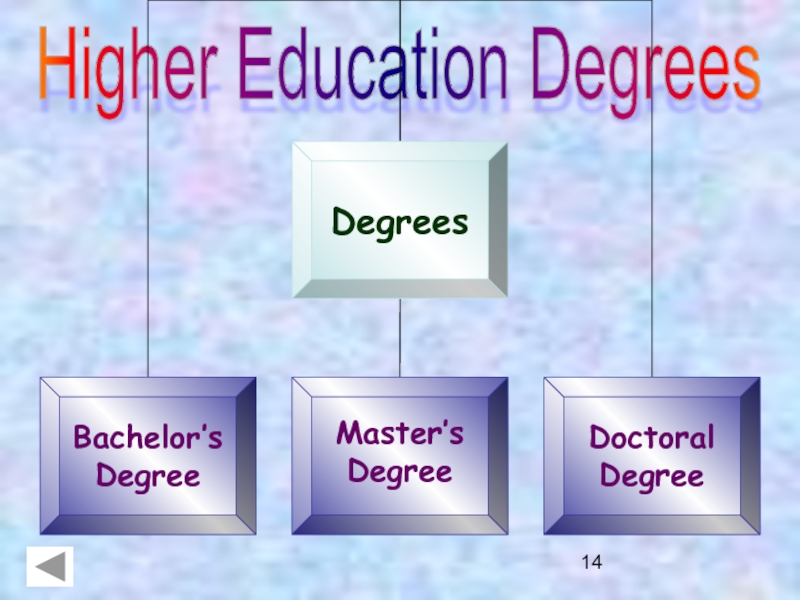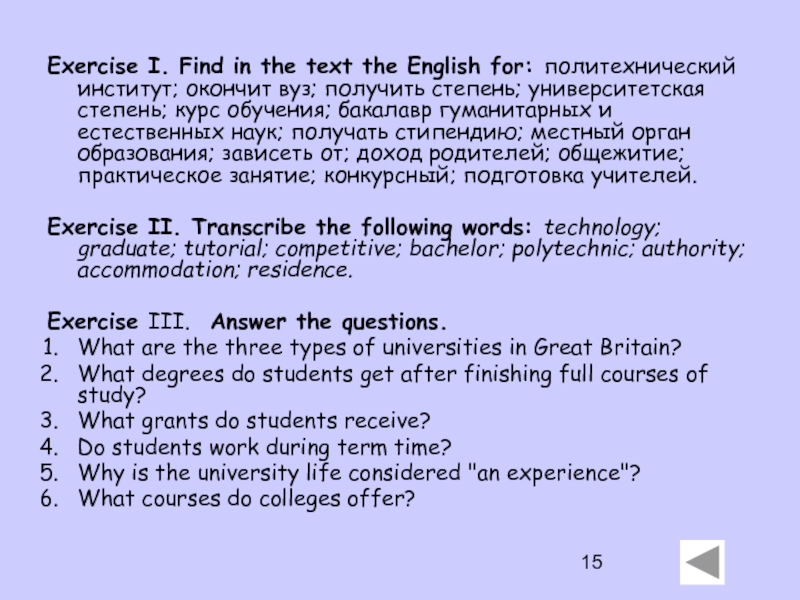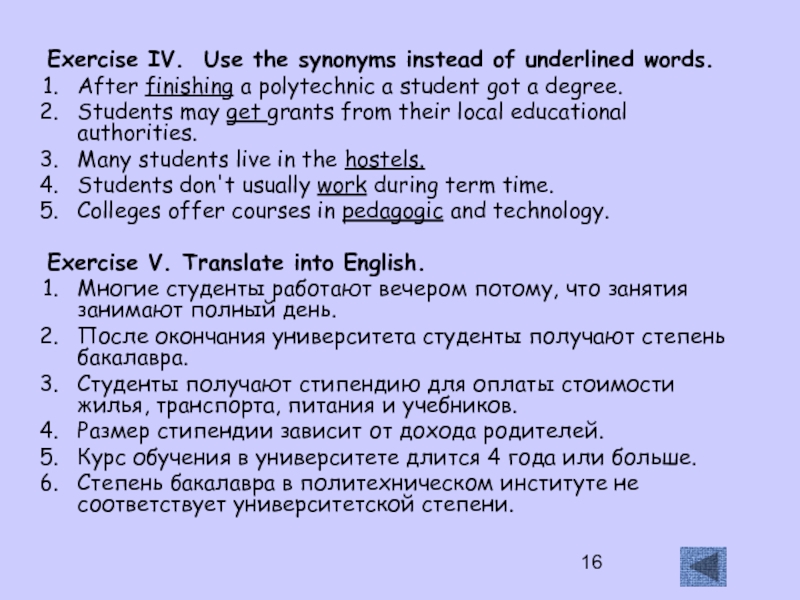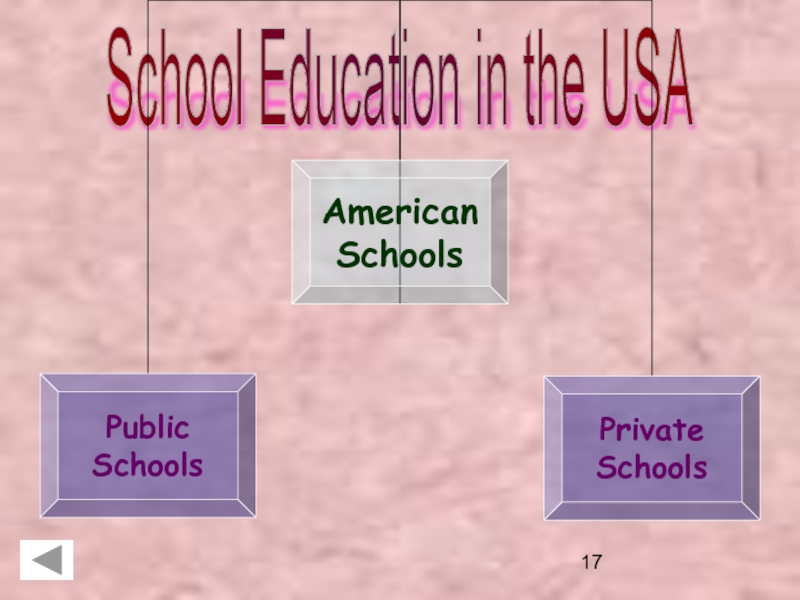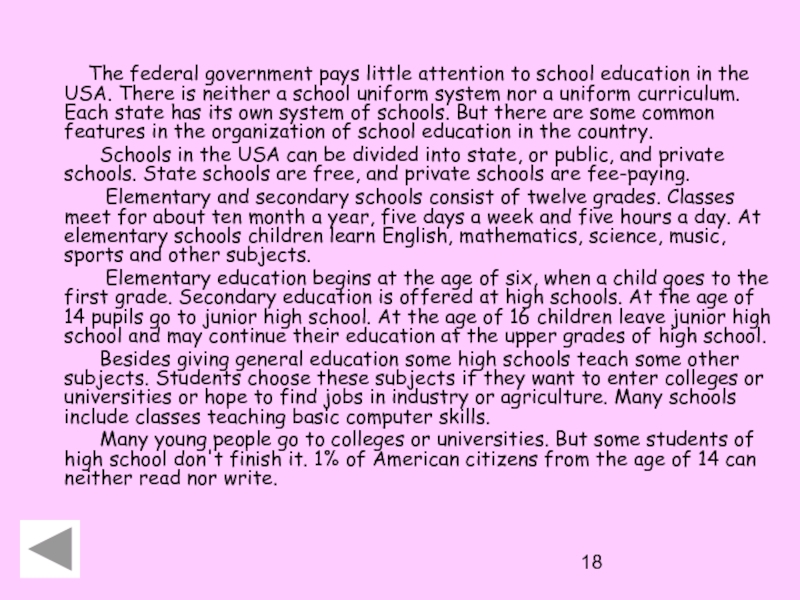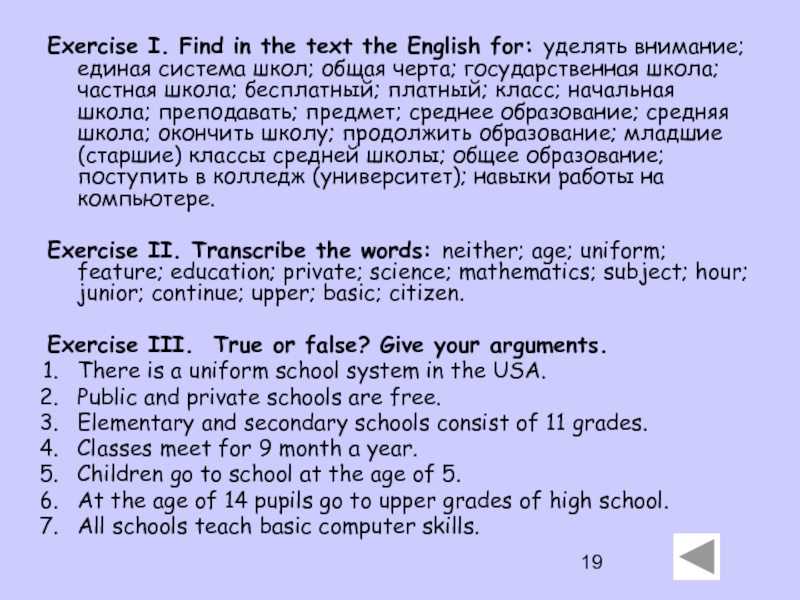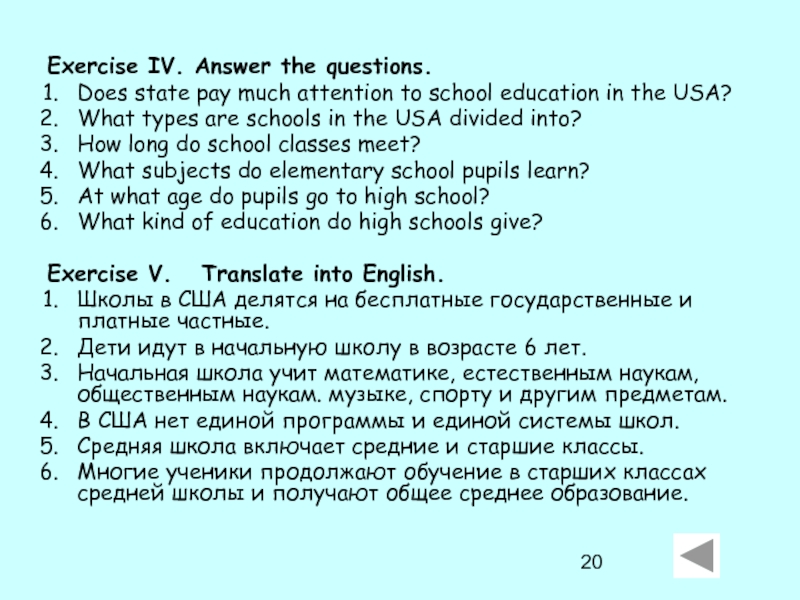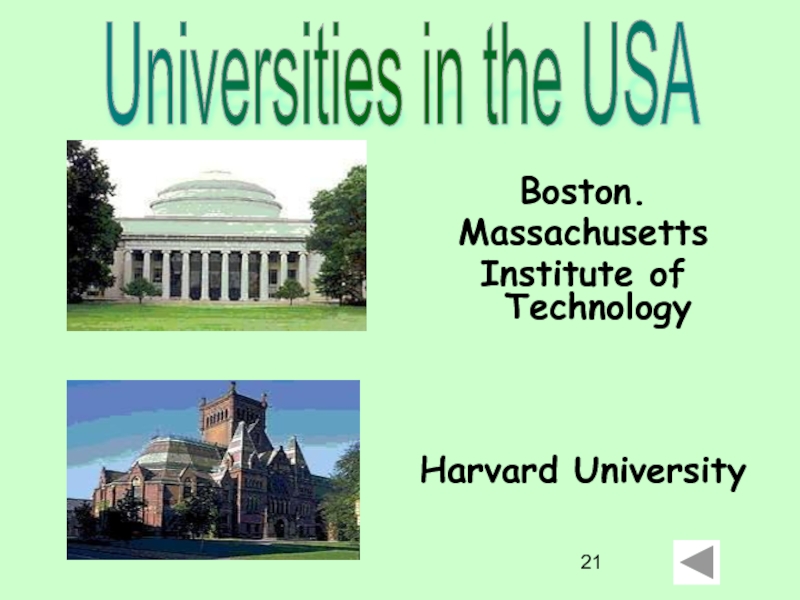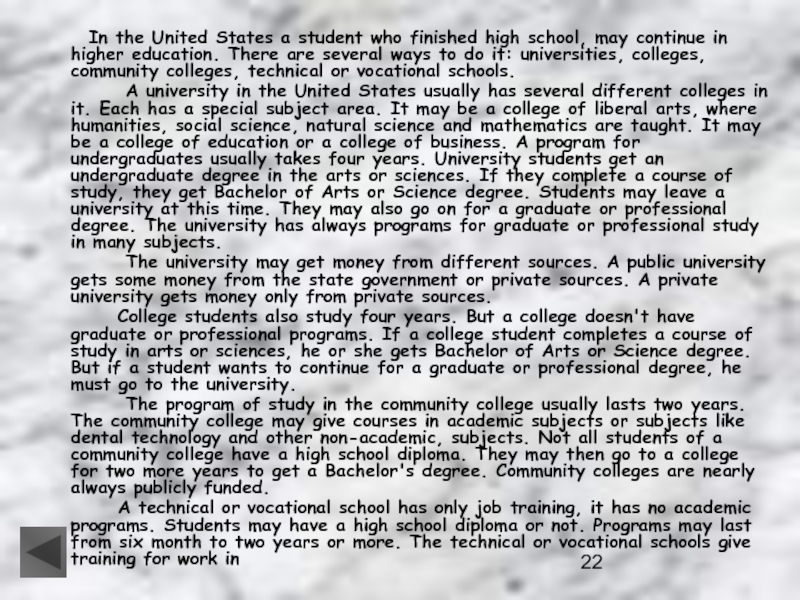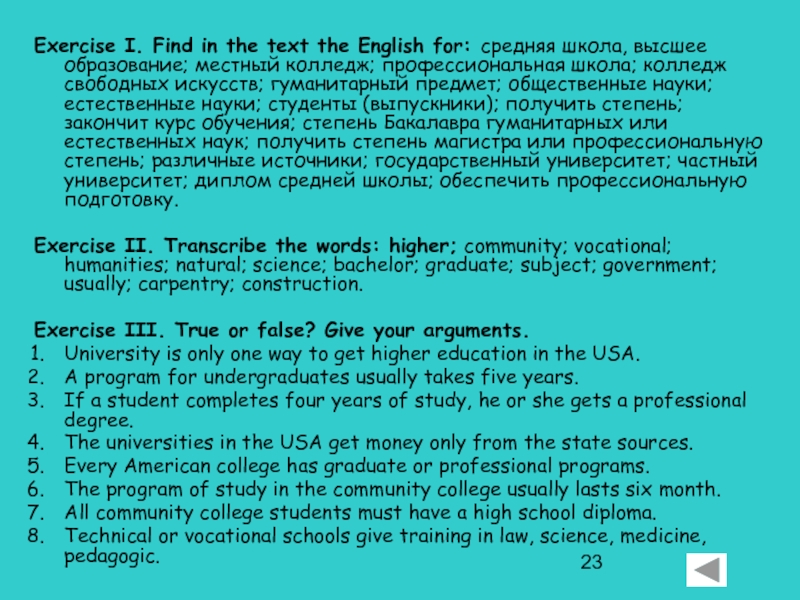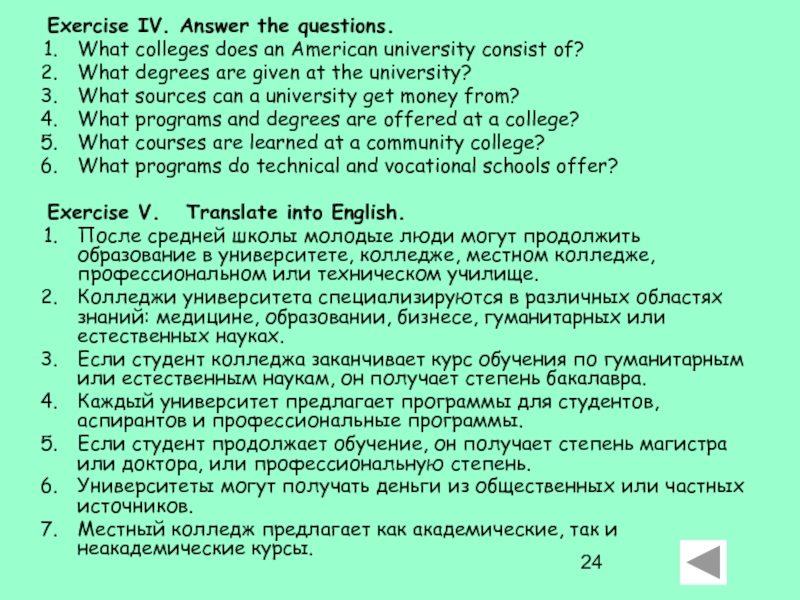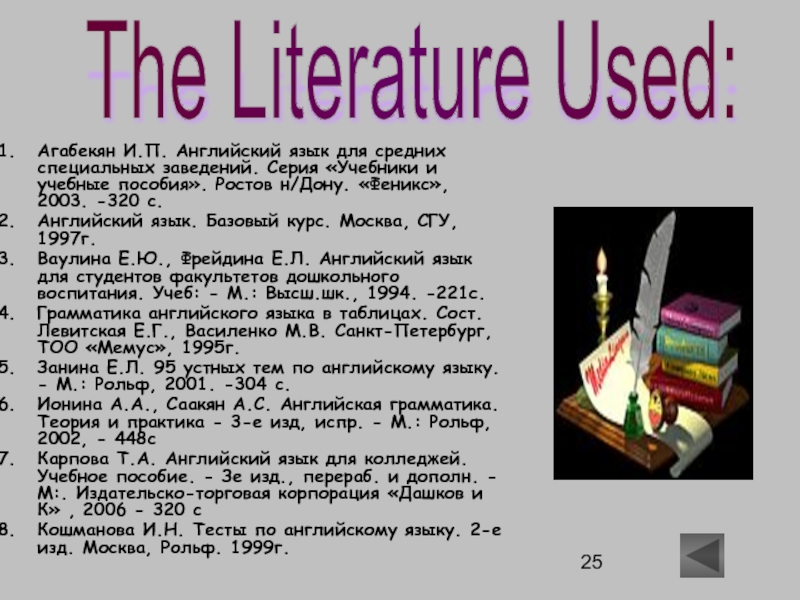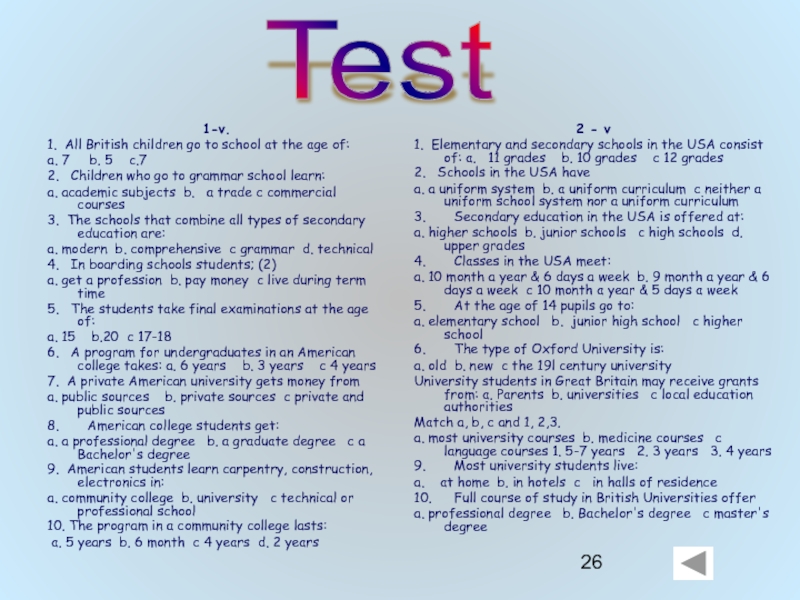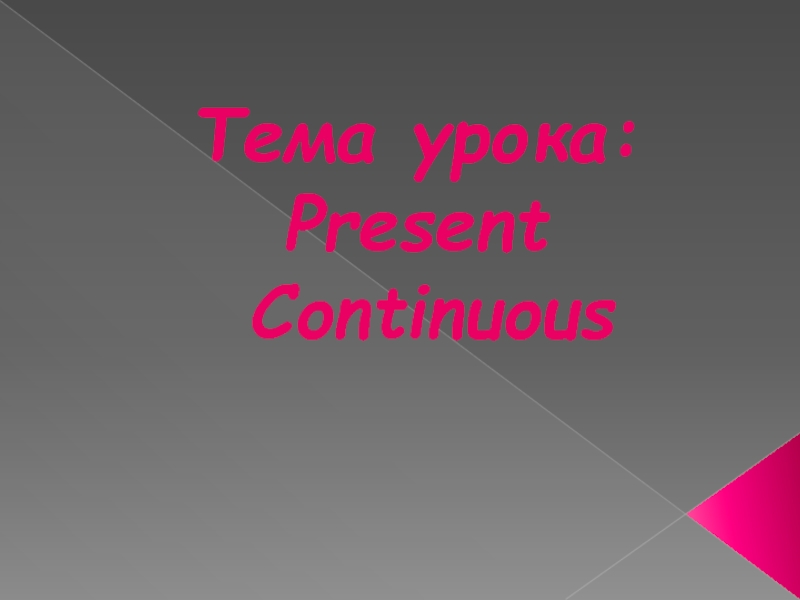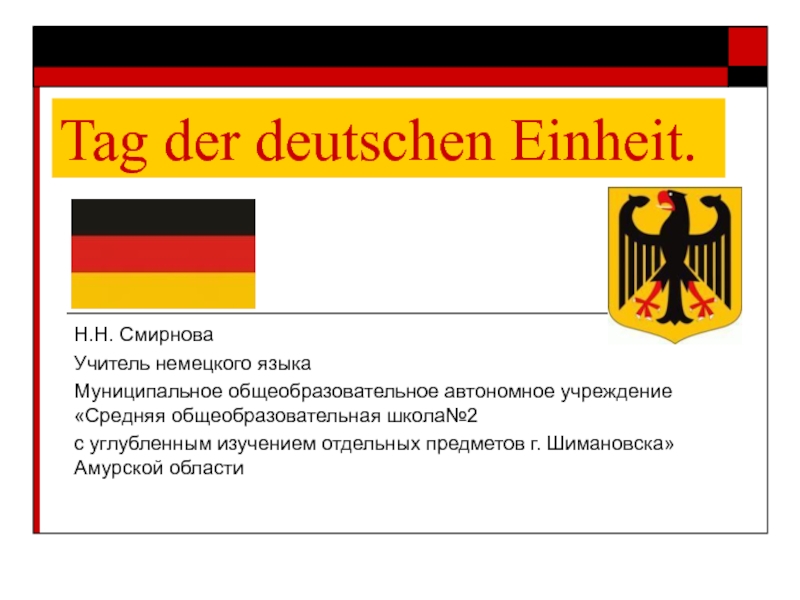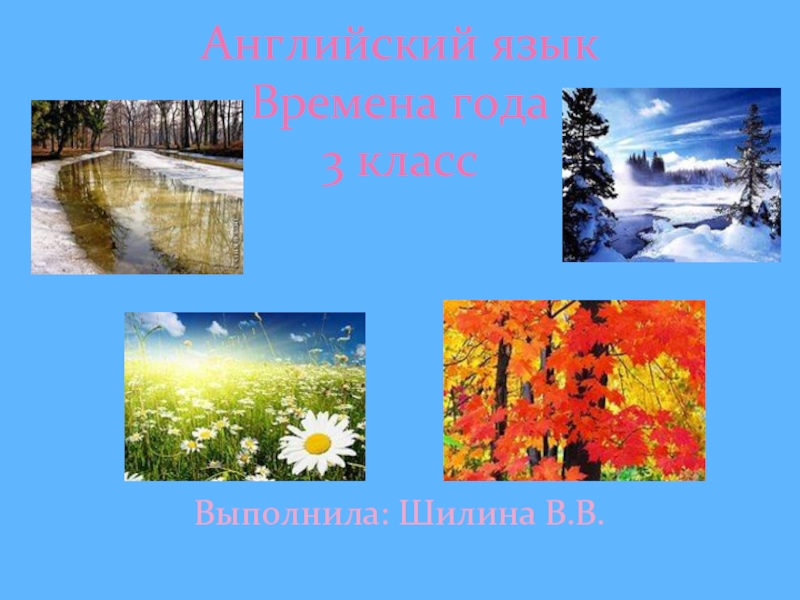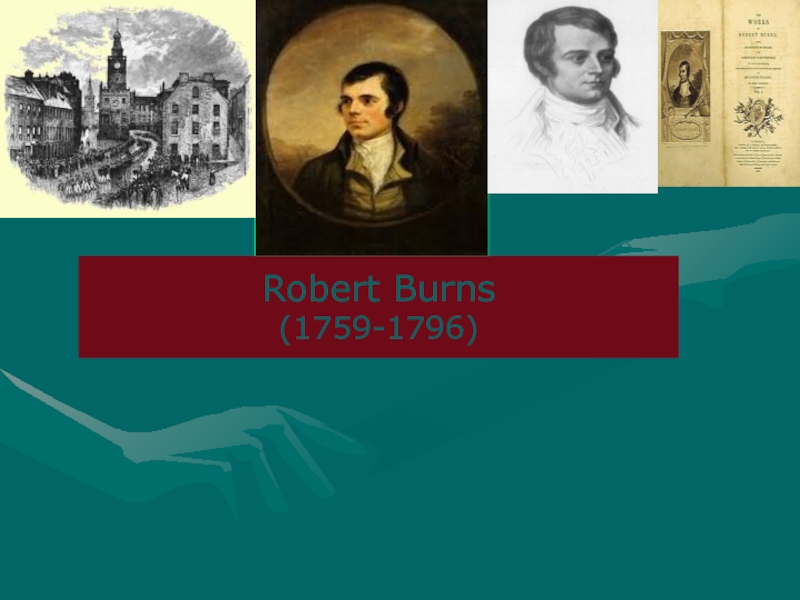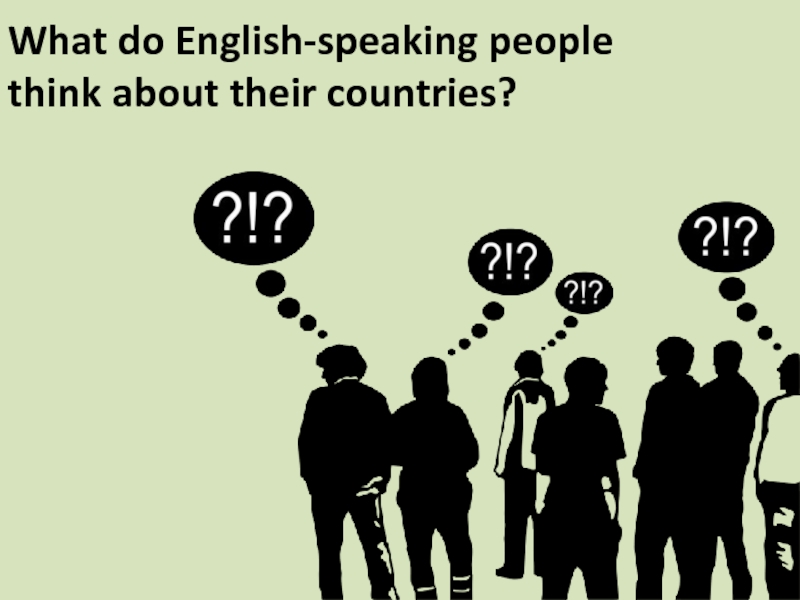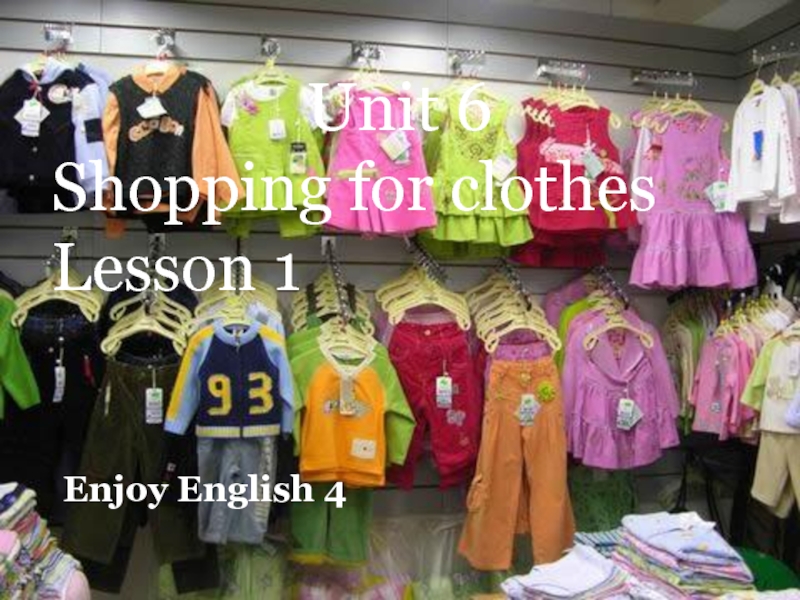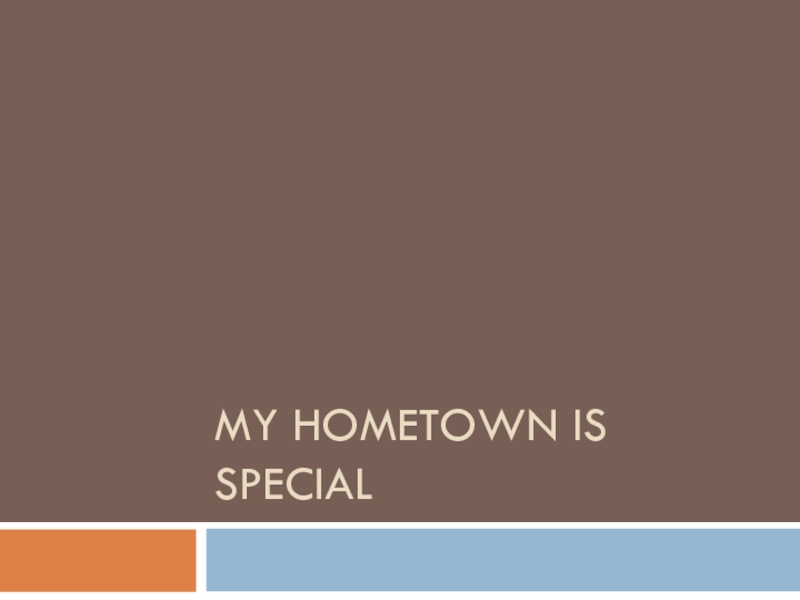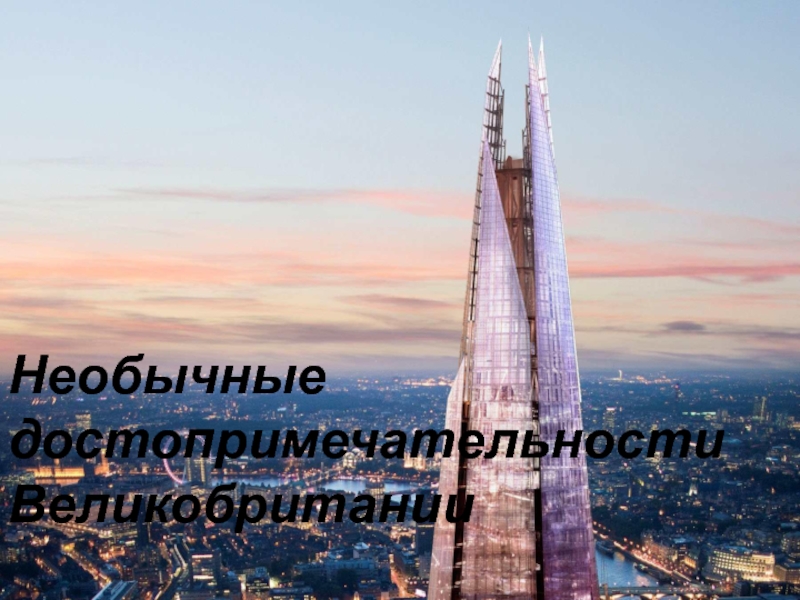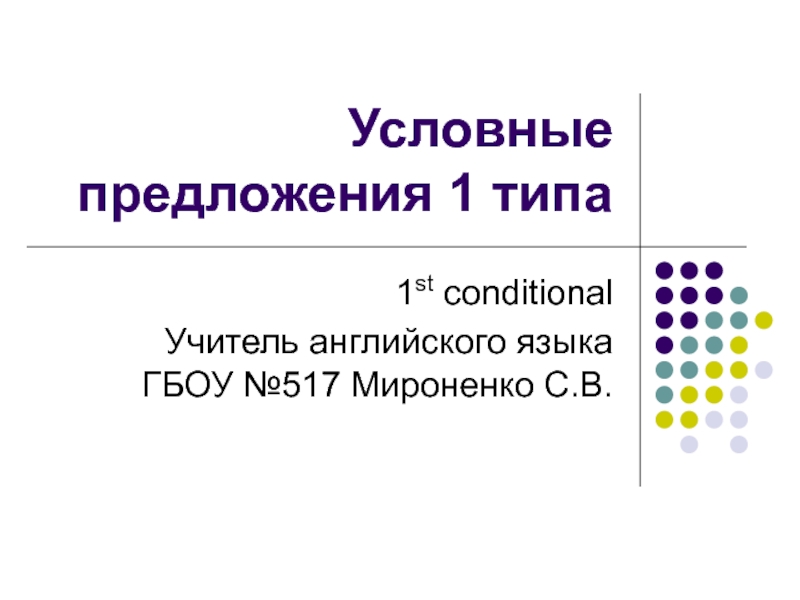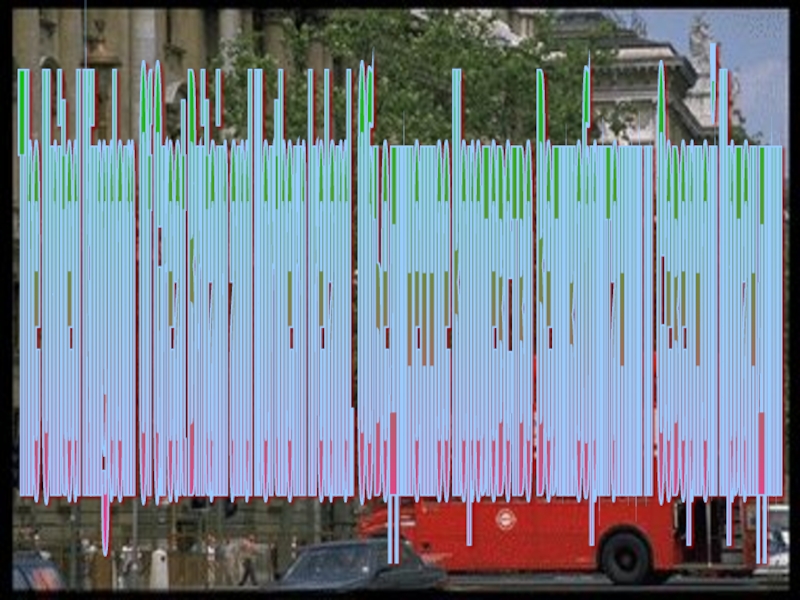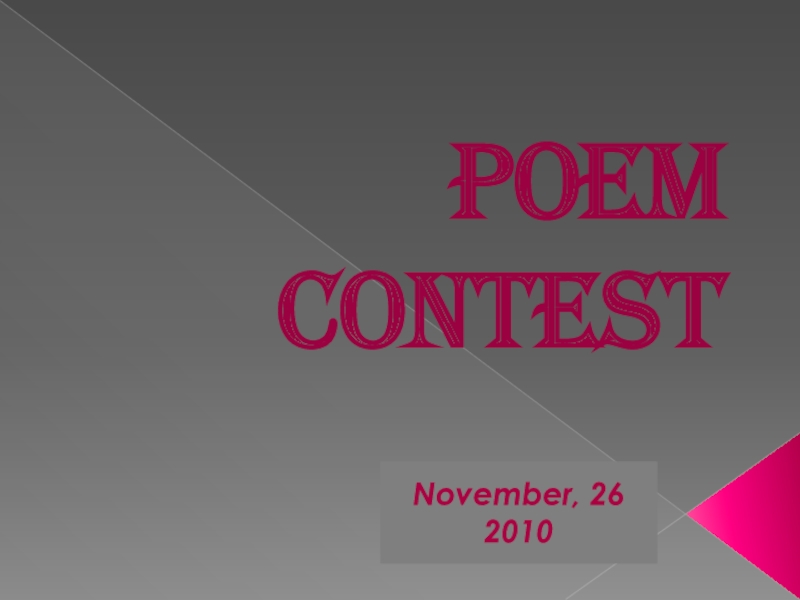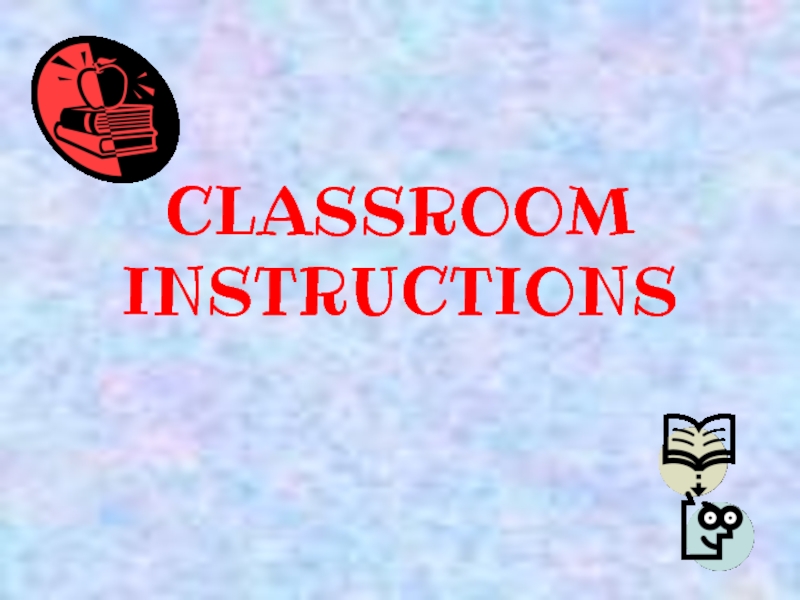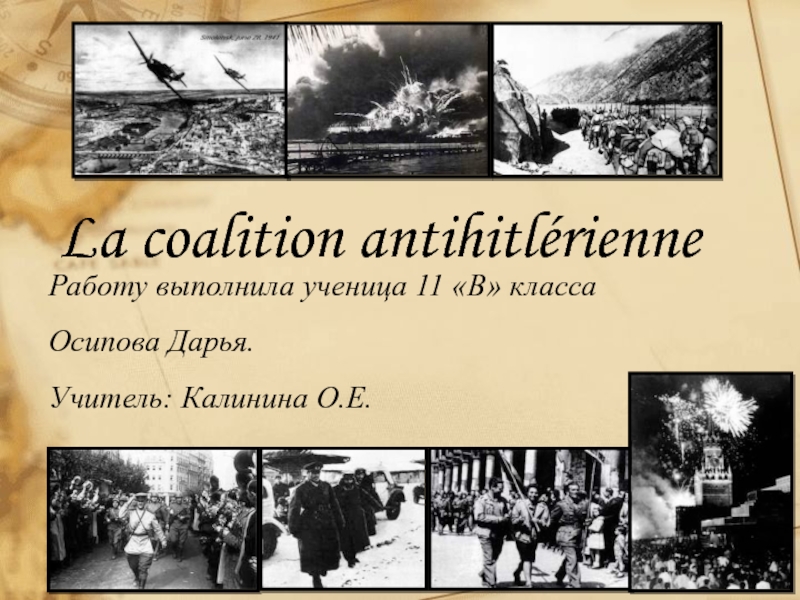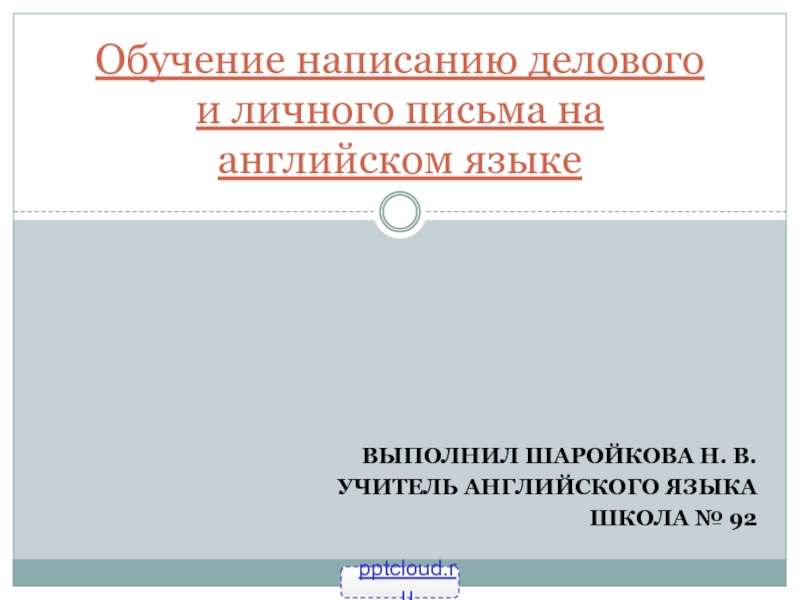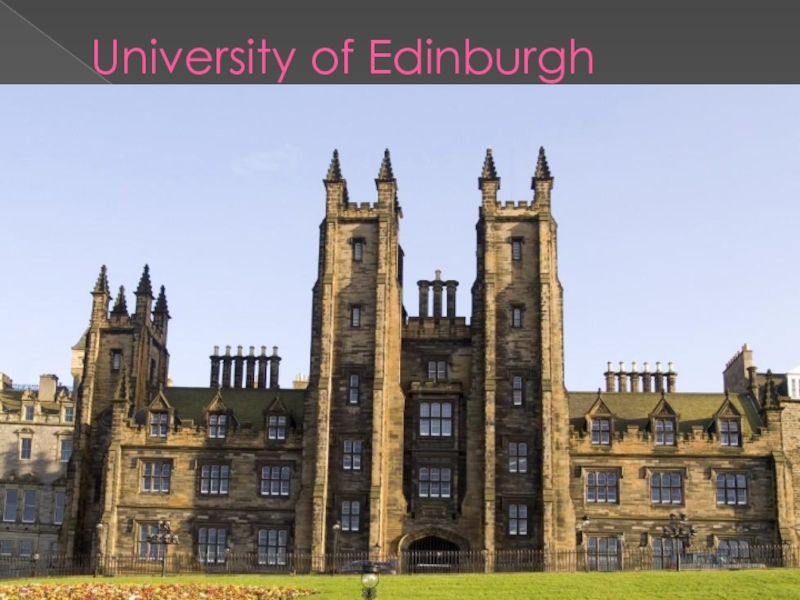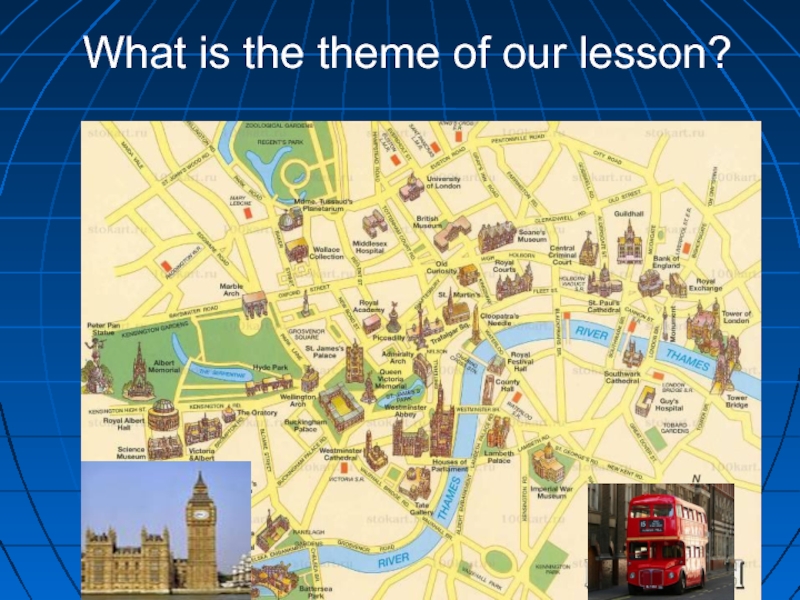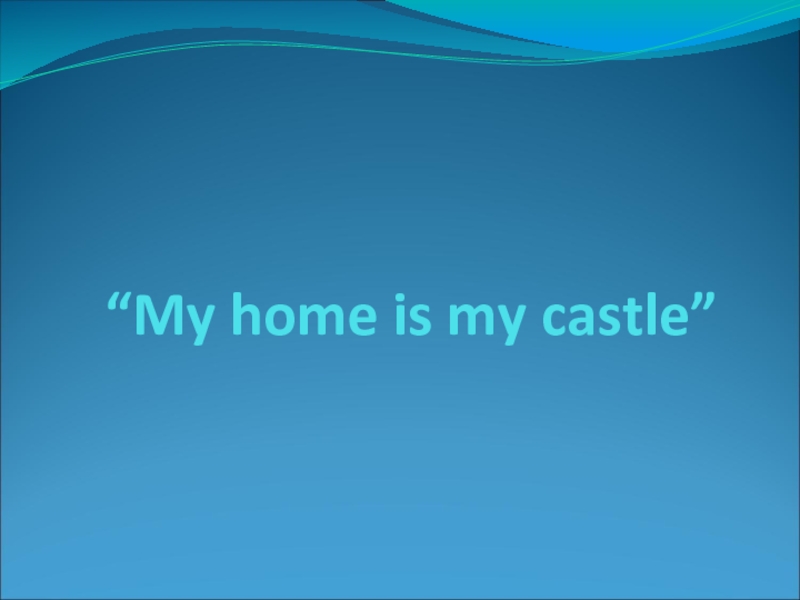Разделы презентаций
- Разное
- Английский язык
- Астрономия
- Алгебра
- Биология
- География
- Геометрия
- Детские презентации
- Информатика
- История
- Литература
- Математика
- Медицина
- Менеджмент
- Музыка
- МХК
- Немецкий язык
- ОБЖ
- Обществознание
- Окружающий мир
- Педагогика
- Русский язык
- Технология
- Физика
- Философия
- Химия
- Шаблоны, картинки для презентаций
- Экология
- Экономика
- Юриспруденция
Education
Содержание
- 1. Education
- 2. Education in Russian FederationBritish SchoolsBritish UniversitiesSchool Education in the USAHigher Education in the USAContents
- 3. The Moscow StateUniversity Education in Russian Federation
- 4. Слайд 4
- 5. Exercise I. Find in the text the
- 6. Exercise III. Correct the false sentences. Use
- 7. Exercise V. Translate into English, using the
- 8. British Schools
- 9. All
- 10. Exercise I. Find in the text the
- 11. Exercise IV. Answer the questions.When do
- 12. Oxford. Trinity College.Cambridge UniversityBritish Universities
- 13. Слайд 13
- 14. Higher Education Degrees
- 15. Exercise I. Find in the text the
- 16. Exercise IV. Use the synonyms instead of
- 17. School Education in the USA
- 18. Слайд 18
- 19. Exercise I. Find in the text the
- 20. Exercise IV. Answer the questions.Does state pay
- 21. Boston.Massachusetts Institute of TechnologyHarvard UniversityUniversities in the USA
- 22. Слайд 22
- 23. Exercise I. Find in the text the
- 24. Exercise IV. Answer the questions.What colleges does
- 25. Агабекян И.П. Английский язык для средних специальных
- 26. 1-v.1. All British children go to school
- 27. Скачать презентанцию
Слайды и текст этой презентации
Слайд 2
Education in Russian Federation
British Schools
British Universities
School Education in the USA
Higher
Education in the USA
Слайд 4
Every citizen has the right to education. This right
is guaranteed by the Constitution. It is not only a right but a duty, too. Every boy or girl must get secondary education. They go to school at the age of six or seven and must stay there until they are 14-17 years old. At school pupils study academic subjects, such as Russian, Literature, Mathematics, History, Biology, a Foreign Language and others.After finishing nine forms of secondary school young people can continue their education in the 10th and the 11th form. They can also go to a vocational or technical school, where they study academic subjects and receive a profession. A college gives general knowledge in academic subjects and a profound knowledge in one ore several subjects.
After finishing a secondary, vocational, technical school or a college, young people can start working or enter an institute or a university. Institutes and universities train specialists in different fields. A course at an institute or a university usually takes five years. Many have evening and extramural departments. They give their students an opportunity to study without leaving their jobs. Institutes and universities usually have graduate courses which give candidate or doctoral degrees.
Education in this country is free at most schools. There are some private primary or secondary schools where pupils have to pay for their studies. Students of institutes or universities get scholarships. At many institutes or universities there are also departments where students have to pay for their education.
Слайд 5Exercise I. Find in the text the English for: право
на образование; гарантироваться; среднее образование; получать образование; общеобразовательный предмет; училище,
техникум, получить профессию; общие знания, углубленные знания; поступить в институт; готовить специалиста; курс обучения; вечернее отделение; заочное отделение; предоставить возможность; без отрыва от работы; аспирантура; кандидатская (докторская) степень; бесплатный; частная школа; начальная школа; получать стипендию; платить за образование.Exercise II. Transcribe the words. Read them aloud: citizen; guaranteed; subject; biology; foreign language; knowledge; profound; extramural; opportunity; without; graduate; private; scholarship; department.
Слайд 6Exercise III. Correct the false sentences. Use the phrase of
agreement( it's true, right, I agree on the point) or
disagreement (it's wrong, false, I disagree) and vocabulary from task 1.All Russian children must get primary education.
The right to education is guaranteed by the Constitution.
At school pupils study Special and academic subjects.
After finishing nine forms of a secondary school pupils must leave school.
At technical or vocational schools young people receive a profession only.
Young people can enter an institute or a university after finishing a college only.
A course at an institute or a university lasts 3-4 years.
Education in Russia is free in all schools and institutes.
Exercise IV. Answer the questions.
What does the right to education mean?
Why is education a duty, too?
What subjects do pupils study at school?
What can young people do after finishing the 9' form?
What subjects do young people study at technical schools or colleges?
What can young people do after finishing the 11th form?
What departments are there at institutes or universities?
Do children and people in Russia have to pay for education?
Слайд 7Exercise V. Translate into English, using the vocabulary of the
text. Mind The Present Simple and the verb "to be".
Право
на образование в России гарантируется Конституцией.В средней школе ученики изучают академические предметы.
После окончания девятого класса средней школы молодые люди могут пойти в техникум или ПТУ.
Там они изучают академические предметы и получают специальное образование.
Молодые люди могут продолжить образование в колледже, дающем углубленные знания по одному или нескольким предметам.
Курс обучения в институте или университете продолжается 5 лет.
Студенты заочного или вечернего отделения могут получить образование без отрыва от работы.
Начальное и среднее образование в России бесплатно в большинстве школ.
В частных школах, колледжах или университетах учащиеся должны платить за образование.
Exercise VI. The communicative task. Describe: a) the school you studied in;
b) the college you study in. Mind proper tenses. Use the vocabulary of the text.
Слайд 9 All British children must
stay at school from the age of 5 until they
are 16. Many of them stay longer and take final examinations when they are 17 or 18. There are different types of secondary schools.State schools are divided into the following types:
Grammar schools. Children who go to grammar schools usually prefer academic subjects, although many grammar schools now also have some technical courses.
Technical schools. Some children go to technical schools. Most courses there are either commercial or technical.
Modern schools. Boys and girls who are interested in working with their hands and learning in a practical way can go to a technical school and learn some trade.
Comprehensive schools. These schools usually combine all types of secondary education. They have physics, chemistry, biology, laboratories, machine workshop for metal and woodwork and also geography, history and art departments, commercial and domestic courses.
There are also many schools which the state does not control. They are private schools. They charge fees for educating children, and many of them are boarding schools, at which pupils live during the term time.
After leaving school many young people go to colleges of further education. Those who become students at Colleges of Technology come from different schools at different ages between 15 and 17. The lectures at such colleges, each an hour long, start at 9.15 in the morning and end at 4.45 in the afternoon.
Слайд 10Exercise I. Find in the text the English for: выпускные
экзамены; сдавать экзамены; государственная школа; средняя школа; технические предметы; современная
школа; профессия, ремесло; общеобразовательная школа; мастерская; домоведение; частная школа; брать плату за образование; школа-интернат; семестр; технический колледж; лекция.
Exercise II. Transcribe the words. Read them aloud: final; through; commercial; physics; chemistry; biology; geography; workshop; private; boarding; further; technology.
Exercise III. True or false? Give your arguments.
All British children must stay at school from 7 until 18.
State schools are divided into 2 types.
In grammar schools most courses are either commercial or technical.
Modern schools usually combine all types of schools.
In comprehensive schools pupils mostly study academic subjects.
Technical schools teach children to work with their hands.
The state controls all private schools.
After leaving schools all pupils must start to work.
Слайд 11Exercise IV. Answer the questions.
When do British children start
going to school?
When do they take their examinations?
Do children pay
money for their studies in all schools?In what type of school do pupils learn to work with their hands?
What is grammar school?
What school combines all types of secondary education?
What is boarding school?
Exercise V. Translate into English.
Британские дети должны учиться в школе с 5 до 16 лет.
Ученики сдают экзамены в 16 лет.
Общеобразовательная школа учит физике, химии, биологии, математике, истории, искусству, коммерции и домоводству.
Большинство частных школ - школы-интернаты, где ученики живут во время учебного семестра.
В 16 лет многие ученики заканчивают школу и идут в колледж дальнейшего образования.
Слайд 13
There are about 90 universities in Great Britain.
They are divided into 3 types: the old universities (Oxford, Cambridge and Edinburgh Universities), the 19lh century universities such as London and Manchester Universities, and the new universities. Some years ago there were also polytechnics. After graduating from a polytechnic the student got a degree, but it was not a university degree. 31 former polytechnics were given university status in 1992.Full courses of study offer the degree of Bachelor of Arts or Science. Most degree courses at universities last 3 years, language course 4 years (including a year spent abroad). Medicine and dentistry courses are longer - 5-7 years. Students may receive grant from their local education authority to help pay for books, accommodation, transport and food. The grant depends on the income of their parents
Most students live away from home in flats or halls of residence.
Students don't usually have jobs during term time because the lessons called lectures and seminars , classes or tutorial (in small groups) are full time. However, many students have to work in the evenings.
University life is considered "an experience". The exams are competitive but the social life and living away from home are also important. The social life is excellent with lots of bars, concerts, clubs and parties.
There are not only universities in Britain but colleges. Colleges offer courses in teacher training, technology and some professions connected with medicine.
Слайд 15Exercise I. Find in the text the English for: политехнический
институт; окончит вуз; получить степень; университетская степень; курс обучения; бакалавр
гуманитарных и естественных наук; получать стипендию; местный орган образования; зависеть от; доход родителей; общежитие; практическое занятие; конкурсный; подготовка учителей.Exercise II. Transcribe the following words: technology; graduate; tutorial; competitive; bachelor; polytechnic; authority; accommodation; residence.
Exercise III. Answer the questions.
What are the three types of universities in Great Britain?
What degrees do students get after finishing full courses of study?
What grants do students receive?
Do students work during term time?
Why is the university life considered "an experience"?
What courses do colleges offer?
Слайд 16Exercise IV. Use the synonyms instead of underlined words.
After finishing
a polytechnic a student got a degree.
Students may get grants
from their local educational authorities.Many students live in the hostels.
Students don't usually work during term time.
Colleges offer courses in pedagogic and technology.
Exercise V. Translate into English.
Многие студенты работают вечером потому, что занятия занимают полный день.
После окончания университета студенты получают степень бакалавра.
Студенты получают стипендию для оплаты стоимости жилья, транспорта, питания и учебников.
Размер стипендии зависит от дохода родителей.
Курс обучения в университете длится 4 года или больше.
Степень бакалавра в политехническом институте не соответствует университетской степени.
Слайд 18
The federal government pays little attention to school education
in the USA. There is neither a school uniform system nor a uniform curriculum. Each state has its own system of schools. But there are some common features in the organization of school education in the country.Schools in the USA can be divided into state, or public, and private schools. State schools are free, and private schools are fee-paying.
Elementary and secondary schools consist of twelve grades. Classes meet for about ten month a year, five days a week and five hours a day. At elementary schools children learn English, mathematics, science, music, sports and other subjects.
Elementary education begins at the age of six, when a child goes to the first grade. Secondary education is offered at high schools. At the age of 14 pupils go to junior high school. At the age of 16 children leave junior high school and may continue their education at the upper grades of high school.
Besides giving general education some high schools teach some other subjects. Students choose these subjects if they want to enter colleges or universities or hope to find jobs in industry or agriculture. Many schools include classes teaching basic computer skills.
Many young people go to colleges or universities. But some students of high school don't finish it. 1% of American citizens from the age of 14 can neither read nor write.
Слайд 19Exercise I. Find in the text the English for: уделять
внимание; единая система школ; общая черта; государственная школа; частная школа;
бесплатный; платный; класс; начальная школа; преподавать; предмет; среднее образование; средняя школа; окончить школу; продолжить образование; младшие (старшие) классы средней школы; общее образование; поступить в колледж (университет); навыки работы на компьютере.Exercise II. Transcribe the words: neither; age; uniform; feature; education; private; science; mathematics; subject; hour; junior; continue; upper; basic; citizen.
Exercise III. True or false? Give your arguments.
There is a uniform school system in the USA.
Public and private schools are free.
Elementary and secondary schools consist of 11 grades.
Classes meet for 9 month a year.
Children go to school at the age of 5.
At the age of 14 pupils go to upper grades of high school.
All schools teach basic computer skills.
Слайд 20Exercise IV. Answer the questions.
Does state pay much attention to
school education in the USA?
What types are schools in the
USA divided into?How long do school classes meet?
What subjects do elementary school pupils learn?
At what age do pupils go to high school?
What kind of education do high schools give?
Exercise V. Translate into English.
Школы в США делятся на бесплатные государственные и платные частные.
Дети идут в начальную школу в возрасте 6 лет.
Начальная школа учит математике, естественным наукам, общественным наукам. музыке, спорту и другим предметам.
В США нет единой программы и единой системы школ.
Средняя школа включает средние и старшие классы.
Многие ученики продолжают обучение в старших классах средней школы и получают общее среднее образование.
Слайд 22 In the United
States a student who finished high school, may continue in
higher education. There are several ways to do it: universities, colleges, community colleges, technical or vocational schools.A university in the United States usually has several different colleges in it. Each has a special subject area. It may be a college of liberal arts, where humanities, social science, natural science and mathematics are taught. It may be a college of education or a college of business. A program for undergraduates usually takes four years. University students get an undergraduate degree in the arts or sciences. If they complete a course of study, they get Bachelor of Arts or Science degree. Students may leave a university at this time. They may also go on for a graduate or professional degree. The university has always programs for graduate or professional study in many subjects.
The university may get money from different sources. A public university gets some money from the state government or private sources. A private university gets money only from private sources.
College students also study four years. But a college doesn't have graduate or professional programs. If a college student completes a course of study in arts or sciences, he or she gets Bachelor of Arts or Science degree. But if a student wants to continue for a graduate or professional degree, he must go to the university.
The program of study in the community college usually lasts two years. The community college may give courses in academic subjects or subjects like dental technology and other non-academic, subjects. Not all students of a community college have a high school diploma. They may then go to a college for two more years to get a Bachelor's degree. Community colleges are nearly always publicly funded.
A technical or vocational school has only job training, it has no academic programs. Students may have a high school diploma or not. Programs may last from six month to two years or more. The technical or vocational schools give training for work in
Слайд 23Exercise I. Find in the text the English for: средняя
школа, высшее образование; местный колледж; профессиональная школа; колледж свободных искусств;
гуманитарный предмет; общественные науки; естественные науки; студенты (выпускники); получить степень; закончит курс обучения; степень Бакалавра гуманитарных или естественных наук; получить степень магистра или профессиональную степень; различные источники; государственный университет; частный университет; диплом средней школы; обеспечить профессиональную подготовку.Exercise II. Transcribe the words: higher; community; vocational; humanities; natural; science; bachelor; graduate; subject; government; usually; carpentry; construction.
Exercise III. True or false? Give your arguments.
University is only one way to get higher education in the USA.
A program for undergraduates usually takes five years.
If a student completes four years of study, he or she gets a professional degree.
The universities in the USA get money only from the state sources.
Every American college has graduate or professional programs.
The program of study in the community college usually lasts six month.
All community college students must have a high school diploma.
Technical or vocational schools give training in law, science, medicine, pedagogic.
Слайд 24Exercise IV. Answer the questions.
What colleges does an American university
consist of?
What degrees are given at the university?
What sources can
a university get money from?What programs and degrees are offered at a college?
What courses are learned at a community college?
What programs do technical and vocational schools offer?
Exercise V. Translate into English.
После средней школы молодые люди могут продолжить образование в университете, колледже, местном колледже, профессиональном или техническом училище.
Колледжи университета специализируются в различных областях знаний: медицине, образовании, бизнесе, гуманитарных или естественных науках.
Если студент колледжа заканчивает курс обучения по гуманитарным или естественным наукам, он получает степень бакалавра.
Каждый университет предлагает программы для студентов, аспирантов и профессиональные программы.
Если студент продолжает обучение, он получает степень магистра или доктора, или профессиональную степень.
Университеты могут получать деньги из общественных или частных источников.
Местный колледж предлагает как академические, так и неакадемические курсы.
Слайд 25Агабекян И.П. Английский язык для средних специальных заведений. Серия «Учебники
и учебные пособия». Ростов н/Дону. «Феникс», 2003. -320 с.
Английский язык.
Базовый курс. Москва, СГУ, 1997г.Ваулина Е.Ю., Фрейдина Е.Л. Английский язык для студентов факультетов дошкольного воспитания. Учеб: - М.: Высш.шк., 1994. -221с.
Грамматика английского языка в таблицах. Сост. Левитская Е.Г., Василенко М.В. Санкт-Петербург, ТОО «Мемус», 1995г.
Занина Е.Л. 95 устных тем по английскому языку. - М.: Рольф, 2001. -304 с.
Ионина Α.Α., Саакян А.С. Английская грамматика. Теория и практика - 3-е изд, испр. - М.: Рольф, 2002, - 448с
Карпова Т.А. Английский язык для колледжей. Учебное пособие. - Зе изд., перераб. и дополн. - М:. Издательско-торговая корпорация «Дашков и К» , 2006 - 320 с
Кошманова И.Н. Тесты по английскому языку. 2-е изд. Москва, Рольф. 1999г.
The Literature Used:
Слайд 261-v.
1. All British children go to school at the age
of:
a. 7 b. 5 c.7
2.
Children who go to grammar school learn:a. academic subjects b. a trade с commercial courses
3. The schools that combine all types of secondary education are:
a. modern b. comprehensive с grammar d. technical
4. In boarding schools students; (2)
a. get a profession b. pay money с live during term time
5. The students take final examinations at the age of:
a. 15 b.20 с 17-18
6. A program for undergraduates in an American college takes: a. 6 years b. 3 years с 4 years
7. A private American university gets money from
a. public sources b. private sources с private and public sources
8. American college students get:
a. a professional degree b. a graduate degree с a Bachelor's degree
9. American students learn carpentry, construction, electronics in:
a. community college b. university с technical or professional school
10. The program in a community college lasts:
a. 5 years b. 6 month с 4 years d. 2 years
2 - v
1. Elementary and secondary schools in the USA consist of: a. 11 grades b. 10 grades с 12 grades
2. Schools in the USA have
a. a uniform system b. a uniform curriculum с neither a uniform school system nor a uniform curriculum
3. Secondary education in the USA is offered at:
a. higher schools b. junior schools с high schools d. upper grades
4. Classes in the USA meet:
a. 10 month a year & 6 days a week b. 9 month a year & 6 days a week с 10 month a year & 5 days a week
5. At the age of 14 pupils go to:
a. elementary school b. junior high school с higher school
6. The type of Oxford University is:
a. old b. new с the 19l century university
University students in Great Britain may receive grants from: a. Parents b. universities с local education authorities
Match a, b, с and 1, 2,3.
a. most university courses b. medicine courses с language courses 1. 5-7 years 2. 3 years 3. 4 years
9. Most university students live:
a. at home b. in hotels с in halls of residence
10. Full course of study in British Universities offer
a. professional degree b. Bachelor's degree с master's degree
Test
